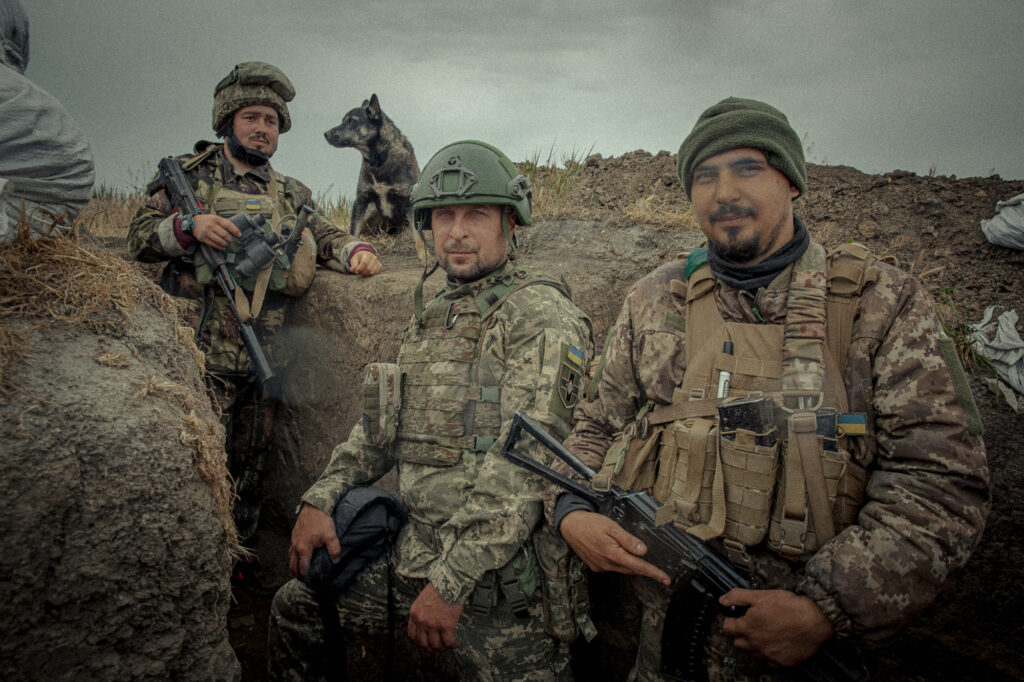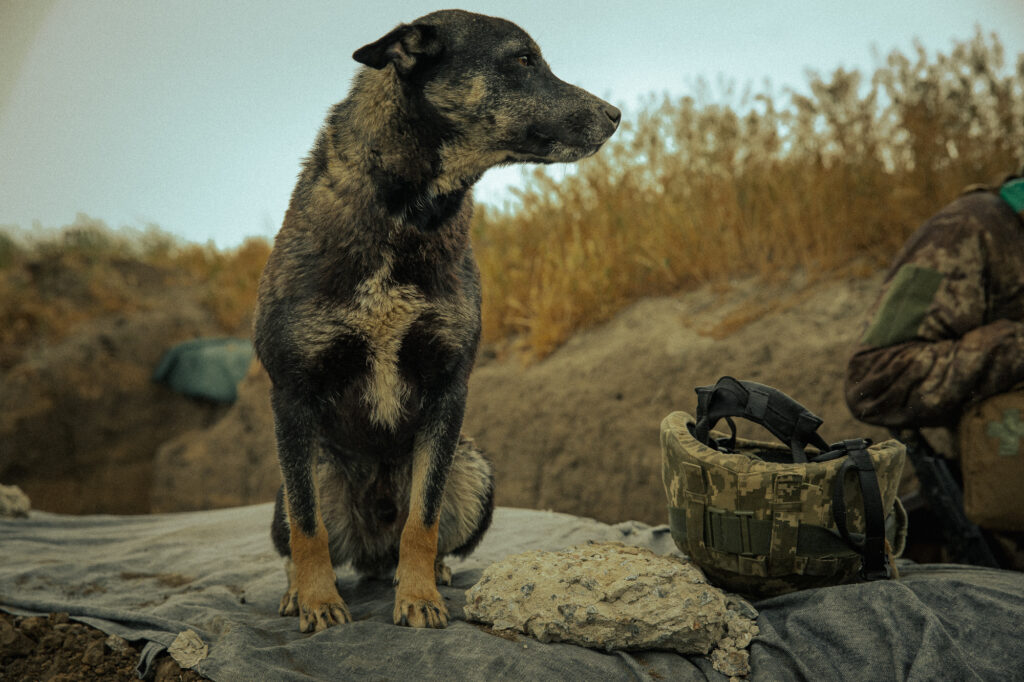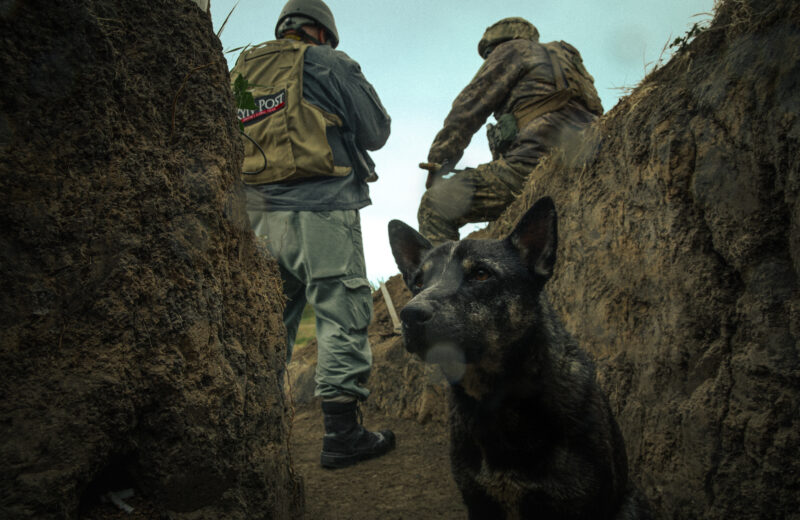Artem Stepashyn, a veteran combat infantryman, is perfectly happy when the front is quiet. So is his battle buddy, a dog named Blackie.
If he’s honest, he told Kyiv Post, one of the attractions of his peacetime job was the risk.
Stepashyn and Blackie currently spend all of their days and most of their nights in a trench line near the village of Frankivske, to the north of the southern Ukrainian city of Mykolaiv.
In the early weeks of the war, an infantryman campaigning in the southern sector fought mostly from armored personnel carriers, ruined buildings or wood lines separating farm fields. During those days, Senior Soldier Stepashyn had only his mates in the 50th Mechanized Infantry Brigade to rely on. Blackie wasn’t around back then.
After about a month of battles, retreats, injured and dead comrades, and sleepless nights, Stepashyn’s battalion, and the rest of the 50th Mechanized Infantry Brigade, dug in their collective heels, fought off days of Russian Federation (RF) bombardments and attacks, and started digging in.
 1A1A5200.jpg – (L-R) Senior Soldier Artem Stepashin, UAF-adopted dog Blackie and two UAF service members take a break at a forward position, Mykolaiv sector (MAKS PILIPENKO)
1A1A5200.jpg – (L-R) Senior Soldier Artem Stepashin, UAF-adopted dog Blackie and two UAF service members take a break at a forward position, Mykolaiv sector (MAKS PILIPENKO)
It seems almost certain that, at the time, RF troops opposite those lines fully appreciated what eight years of war against the Russian army following its 2014 invasion of Donbas had taught the Ukrainian infantry.
Now, at the end of May 2022, the front lines of the Ukrainian Armed Forces (UAF) around Frankivske are slit trenches at least two and often three meters deep. A dirt berm thick enough to shrug off a direct hit from tank cannon runs the length of the trenches.
About every 20 meters Stepashyn and his mates have built mini-forts with firing slits and covered them with thick logs and dirt proofed them against bullets and shell splinters. If you look closely, along the top of most of the emplacements there is a dog-sized trail with paw prints.
If the RF army starts throwing something really heavy, like howitzer shells or artillery rockets, the Ukrainian infantry have constructed bomb-proof bunkers of reinforced concrete, thick timber and more meters of dirt every 100 meters or so. There is a table, chairs and plates for food. Blackie’s plate is on the floor.
“Our bunker can take a direct hit from pretty much anything the ‘orcs’ (a common Ukrainian term for RF soldiers) can send at us, except for maybe an aerial bomb from an airplane,” Stepashyn said. “But Blackie can hear a plane coming, so when he hides, we do, too.”
Frankivske, which in peace time was a fairly wealthy village whose residents had the money and energy to grow vine trellises, own small tractors and install modern metal-plastic windows, is now mostly flattened. A few people – Stepashyn estimates around 50 of a pre-war population of close to 500 – are still in their homes.
Every house has been damaged, some reduced to rubble. Mortar and howitzer shell craters are everywhere – in gardens, in the asphalt of the village’s main street, and next to trees with trunks snapped in half or still-standing but with most of the branches shredded and all the leaves blown off.
Somewhere in Frankivske, Stepashyn said, Blackie probably had a home, but his owners either died or left.
Frankivske’s most recent RF bombardment, the day before, was from either 122mm or 152mm howitzers. The Russians were apparently searching out Stepashyn’s company headquarters. No-one was hurt, but a Mitsubishi pickup truck donated by volunteers to the 50th was smashed.
There was little left of it after it burned. The main entrance to the HQ is a steel door at the top of a stoop with a steel pipe railing on the side. Shell splinters have punched holes into the steel and cut down one of the guard rails.
Now, Stepashyn said, the defensive lines by Frankivske are quiet and “basically safe.”
“Today, will probably be calm, Russian drones have trouble flying in rain and wind,” he said. “And if they can’t get their drones in the air then the Russians will shoot their cannon a lot less…so Blackie can run around.”
A front line dog that’s attached himself to the UAF infantry is part of the team. Stepashyn said Blackie’s most important combat ability was hearing incoming artillery shells well before humans. So if Blackie takes off for the bunker, the infantryman sharing the trenches don’t second guess, they just follow him.
Blackie has been with Stepashyn’s section for about two months. During that time, Stepashyn and other infantrymen said, Blackie has learned to find mines and unexploded mortar rounds, to bark warnings of enemy foot patrols and armored probes, become the unit’s most reliable detector of incoming howitzer shells, and vet every single visitor to front line positions for trustworthiness, including generals and foreign reporters.
 Blackie, a dog adopted by the UAF infantry, maintains good situational awareness at a trench line in the southern sector, near Mykolaiv (MAKS PILIPENKO)
Blackie, a dog adopted by the UAF infantry, maintains good situational awareness at a trench line in the southern sector, near Mykolaiv (MAKS PILIPENKO)
He pulls night watch when it’s Stepashyn’s turn, eats the same food as the rest of the infantrymen (one hot meal delivered a day, but conditions permitting, they cook for themselves sometimes), and if his section is on the line he sleeps in a dirt bunker like everyone else.
Supposedly, the last time someone was hit – a shell splinter, not bad – Blackie made sure the wounded man got into the ambulance, and to be safe he chased the ambulance away. Also, the absolute absence of rats, not just in the trench lines, but in all of Frankivske, is allegedly the result of Blackie’s hunting skills.
Source:kyivpost.com/ukraine
